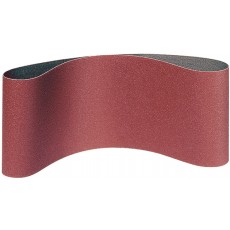
Not sure how to choose the best sanding belt for your machine and application?
This guide is here to help you make the best choice possible!
Picking sanding belts can be somewhat of a daunting task with the combination of all the different grit sizes as well as the types of grain and backing materials on the belts. Let’s start with what type of grain material works best for each application and then we will help you with grit size and backing material.
There are 4 major categories of abrasive sanding belt material that are most common. These are; Aluminum Oxide, Zirconia (sometimes referred to as Zirconia Alumina), Silicon Carbide and Ceramic.
Aluminum Oxide
The “workhorse” of the abrasive grains, developed originally to replace natural grains such as Garnet, aluminum oxide works well on hard and soft woods, non-ferrous metals like aluminum and even on some grades of steel.
Zirconia (Zirconia Alumina)
You can think of Zirconia as the industrial equivalent of Cubic Zirconia from the jewelry industry. This man-made material is very hard and works well in applications where high heat develops from sanding hard materials especially in heavy removal applications. Choice applications for Zirconia are for rough sanding or shaping of very hard woods, steel and stainless steel.
Silicon Carbide
This grain is very similar to the rock called “slate” or “shale”. Very sharp and brittle (we call that “friable” in the abrasive industry). Most commonly found on wet & dry sanding sheets, Silicon Carbide is the grain of choice for belt sanding glass, plastic, rubber, ceramic or other masonry type materials. It is also very popular in the very high grits for fine finishing on both metal and wood.
Ceramic
A relative newcomer to the abrasive sanding belt realm, ceramic belts are a specially heat treated aluminum oxide grain that is extremely hard. Although ceramic grain is more expensive than its counterparts, it will make that up for you in production when you look over the longer term life of the belt. Ceramic belts really shine in hard metal applications such as Stainless Steel, Iconel & Tool Steel.
Surface Conditioning
Also referred to as “Scotch-Brite” belts, these belts provide a satin finish to your metalworking project. Since the grain in these belts is contained within a thick non-woven material, the sanding action is “cushioned” and limits material removal. Available in 3 “grit” choices, you can get Coarse, Medium or Fine surface conditioning belts.
Grit Selection
The size of the grit on the belt determines how rough or smooth the finish will be after using it. A simple way (however not perfectly accurate) way to think of grain size is “how many of these rocks does it take to fill a square inch?” So,16 grit is very coarse and 400 grit is quite fine.
Grits 16, 24, 36, 40, 50 & 60 are for material removal and rough shaping.
Grits 80, 100 &120 are for smoothing surfaces and removing imperfections
Grits 150, 180, 220, 240, 320, 400, 400, 600 and 800 are for final finishing surfaces, or in some cases (flat materials) you may move at this point to a sanding disc instead.
Backing Material
There are 2 categories of backing material for sanding belts; Cloth and Paper backing.
Cloth Backing
Cloth backing is the most durable and versatile backing material for sanding belts. The “weight” of the cloth is indicated by a letter of the alphabet. The further into the alphabet you go, the heavier the backing material.
J-Weight is a light, flexible cloth backing that is suitable for applications where you are sanding over contours.
X-Weight is a medium weight backing that is good for general purpose use.
Y-Weight is a heavy duty backing with the most strength to withstand the pressure of heavy sanding and product removal.
Paper Backing
Paper backing is typically about 20-30% cheaper than cloth backed belts and work well applications where you are working flat surfaces. Most popular uses are on wood working stroke sanders and wide belt sanders. Also indicated by a letter of the alphabet, belts are typically either “E-Weight” or “F-Weight”.
Summary
That should give you a pretty good idea of what belt products will work best for your specific application, keep in mind that even within these categories there are variations designed for specific applications, just check the manufacturers specs on the material to make sure you are getting something suitable for your job… Happy Sanding!
Ready to order? Visit our Custom Sanding Belt Page HERE

 Posted by
Posted by



